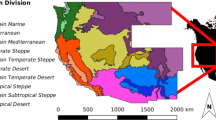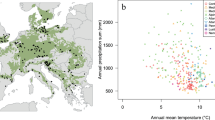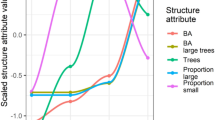Abstract
Within the scientific as well as the popular press there is a growing interest in the declining growth rates and increased mortality of red spruce (Picea rubens Sarg.) in the eastern United States1,2, and the possibility of a causal relationship with anthropogenic pollutants, particularly acidic deposition3–7. To evaluate this relationship we need to consider the long-term (200 year) population trend of this species (which has not been done to date). Potentially long-term changes are being viewed with a short-term perspective, possibly leading to the identification of spurious causal relationships. Using historical and current compositional data from old-growth stands in the spruce–hardwood zone we constructed a 180-year trend in forest composition for central New Hampshire. These data indicate a major decrease in the size of red spruce populations from 1800 to the present. It is proposed that the major driving force of this decline has been a warming trend in both mean annual and mean summer temperatures.
This is a preview of subscription content, access via your institution
Access options
Subscribe to this journal
Receive 51 print issues and online access
$199.00 per year
only $3.90 per issue
Buy this article
- Purchase on Springer Link
- Instant access to full article PDF
Prices may be subject to local taxes which are calculated during checkout
Similar content being viewed by others
References
Siccama, T. G., Bliss, M. & Vogelmann, H. W. Bull. Torrey Bot. Club 109, 162–168 (1982).
Hornbeck, J. W. & Smith, R. B. Can. J. For. Res. 15, 1199–1201 (1985)
Johnson, A. H. & McLaughlin, S. B. in Report of the Committee on Monitoring and Yields in Acidic Deposition, 200–230 (National Research Council, National Academy Press, Washington. DC, 1986).
Shabecofl, P. N.Y. Times (2/26/1984) p. 1, 33.
Johnson, A. H. & Siccama, T. G. Tappi J. 67, 68–72 (1984).
Johnson, A. H. & Siccama, T. G. Environ. Sci. Technol. 17, 294A–305A (1983).
Johnson, R. H., Turner, R. S. & Lord, D. G. in Direct and Indirect Effects of Acid Deposition on Vegetation Vol. 5, (ed. Linthurst, R. A.) (Butterworth, Boston, 1984).
Likens, G. E., Bormann, F. H., Pierce, R. S., Eaton, J. S. & Johnson, N. M. Biogeochemistry of a Forested Ecosystem (Springer, New York, 1977).
Hamburg, S. P. thesis, Yale Univ. (1984).
Chittenden, A. K. in State of New Hampshire Biennial Report of the Forestry Commission 1903–04, 1–219 (Concord, New Hampshire, 1904).
Leak, W. B. U.S.D.A For. Serv. Res. Note NE-186 (1974).
Leak, W. B. U.S.D.A. For. Serv. Res. Note NE-181 (1973).
Martin, C. W. U.S.D.A. For. Serv. Res. Note NE-244 (1977).
Bormann, F. H., Siccama, T. G., Likens, G. E. & Whittaker, R. H. Ecol. Monogr. 40, 373–388 (1970).
Braun, E. L. Deciduous Forests of Eastern North America (Free Press, New York, 1950).
Bourdo, E. A. Jr Ecology 37, 754–768 (1956).
Siccama, T. G. Amer. Mid. Nat. 85, 153–172 (1971).
Weigle, W. C. thesis, Yale Univ. (1904).
Chapman, H. H. The Collected Papers of Herman H. Chapman Vol. 117 (Yale University Manuscript Collection, New Haven, 1906).
Leak, W. B. Ecology 56, 1451–1454 (1975).
Carbonneau, L. thesis, Univ. New Hampshire (1986).
Weiss, M. J., McCreery, L. R., Millers, I., Miller-Weeks, M. & O'Brien, J. T. U.S.D.A For. Serv. Northeastern Area NA-TP-11 (1985).
Fox, W. F. in Annual Report of the Forestry Commission for 1894 (Forestry Commission of the State of New York, Albany 1895).
Mook, P. V. & Eno, H. G. U.S.D.A. For. Serv. For. Res. Notes 59, 1–2 (1956).
Davis, M. B. in The Quaternary of the United States (eds Wright, H. E. Jr & Frey, D. G.) 377–401 (Princeton University Press, 1965).
Terasmae, J. & Anderson, T. W. Can. J. Earth Sci. 7, 406–413 (1970).
Davis, M. B., Spear, R. W. & Shane, L. C. K. Quat. Res. 14, 240–250 (1980).
Spear, R. W. thesis, Univ. Minnesota (1982).
Likens, G. E. & Davis, M. B. Verh. Internat. Verein. Limnol. 19, 982–993 (1975).
Whitehead, D. R. Quat. Res. 12, 333–357 (1979).
Davis, R. B., Bradstet, T. E., Stuckenrath, R. Jr & Borns, H. W. Jr. Quat. Res. 5, 435–465 (1975).
Davis, M. B. in Late-Quaternary Environments of the United States, VoL 2, The Holocene (ed. Wright, H. E. Jr.) 166–181 (University of Minnesota Press, 1984).
Spurr, S. H. Anier. J. Sci. 251, 682–688 (1953).
Conkey, L. thesis, Univ. Arizona (1982).
Cook, E. R., Johnson, A. H. & Biasing, T. J. Tree Phys. 3, 27–40 (1987).
McLaughlin, S. B., Downing, D. J., Biasing, T. J., Cook, E. R. & Adam, H. S. Oecologia 72, 487–501 (1987).
Davis, M. B. & Botkin, D. B. Quat. Res. 23, 327–340 (1985).
Bradley, R., Ives, P. T. & Eischeid, J. The Climate of Amherst (University of Massachusetts, Amherst. 1987).
Author information
Authors and Affiliations
Rights and permissions
About this article
Cite this article
Hamburg, S., Cogbill, C. Historical decline of red spruce populations and climatic warming. Nature 331, 428–431 (1988). https://doi.org/10.1038/331428a0
Received:
Accepted:
Issue Date:
DOI: https://doi.org/10.1038/331428a0
This article is cited by
-
Assessing the Vulnerability of Military Installations in the Coterminous United States to Potential Biome Shifts Resulting from Rapid Climate Change
Environmental Management (2020)
-
Regional- and watershed-scale analysis of red spruce habitat in the southeastern United States: implications for future restoration efforts
Plant Ecology (2017)
-
Site-level importance of broadleaf deciduous trees outweighs the legacy of high nitrogen (N) deposition on ecosystem N status of Central Appalachian red spruce forests
Plant and Soil (2016)
-
Red and black spruce provenance growth and allocation under ambient and elevated CO2
Trees (2015)
-
Carbon assimilation variation and control in Picea rubens, Picea mariana, and their hybrids under ambient and elevated CO2
Trees (2014)
Comments
By submitting a comment you agree to abide by our Terms and Community Guidelines. If you find something abusive or that does not comply with our terms or guidelines please flag it as inappropriate.



